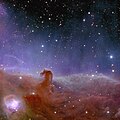Fail:Euclid’s view of the Horsehead Nebula ESA25170866.jpg

Algfail (8200 × 8200 pikslit, faili suurus: 1,84 MB, MIME tüüp: image/jpeg)
| See fail ja sellest kastist allapoole jääv kirjeldus pärinevad kesksest failivaramust Wikimedia Commons. | Faili lehekülg Commonsis |
Lühikirjeldus
| KirjeldusEuclid’s view of the Horsehead Nebula ESA25170866.jpg |
English: Euclid shows us a spectacularly panoramic and detailed view of the Horsehead Nebula, also known as Barnard 33 and part of the constellation Orion.
At approximately 1375 light-years away, the Horsehead—visible as a dark cloud shaped like a horse’s head—is the closest giant star-forming region to Earth. It sits just to the south of star Alnitak, the easternmost of Orion’s famous three-star belt, and is part of the vast Orion molecular cloud. [Image description: This square astronomical image is divided horizontally by a waving line between a white-orange cloudscape forming a nebula along the bottom portion and a comparatively blue-purple-pink upper portion. From the nebula in the bottom half of the image, an orange cloud shaped like a horsehead sticks out. In the bottom left of the image, a white round glow is visible. The clouds from the bottom half of the image shine purple/blue light into the upper half. The top of the image shows the black expanse of space. Speckled across both portions is a starfield, showing stars of varying sizes and colours. Blue stars are younger and red stars are older.] Tiếng Việt: Tinh vân Đầu Ngựa, còn được gọi là Barnard 33 và là một phần của chòm sao Orion |
| Kuupäev | 7. november 2023 (upload date) |
| Allikas | Euclid’s view of the Horsehead Nebula |
| Autor | ESA/Euclid/Euclid Consortium/NASA image processing by J.-C. Cuillandre (CEA Paris-Saclay) G. Anselmi |
| Teised versioonid |
|
| Activity InfoField | Space Science |
| Keyword InfoField | Horsehead Nebula Stars |
| Mission InfoField | Euclid |
| Set InfoField | Euclid First Images |
|

|
This image was selected as picture of the day on Vietnamese Wikipedia.
|
Litsents
This media was created by the European Space Agency (ESA).
Where expressly so stated, images or videos are covered by the Creative Commons Attribution-ShareAlike 3.0 IGO (CC BY-SA 3.0 IGO) licence, ESA being an Intergovernmental Organisation (IGO), as defined by the CC BY-SA 3.0 IGO licence. The user is allowed under the terms and conditions of the CC BY-SA 3.0 IGO license to Reproduce, Distribute and Publicly Perform the ESA images and videos released under CC BY-SA 3.0 IGO licence and the Adaptations thereof, without further explicit permission being necessary, for as long as the user complies with the conditions and restrictions set forth in the CC BY-SA 3.0 IGO licence, these including that:
See the ESA Creative Commons copyright notice for complete information, and this article for additional details.
|
 | |
See fail kuulub Creative Commonsi valitsusvahelise organisatsiooni litsentsi "Autorile viitamine + jagamine samadel tingimustel 3.0" alla. Omistamine: ESA/Euclid/Euclid Consortium/NASA, image processing by J.-C. Cuillandre (CEA Paris-Saclay), G. Anselmi, CC BY-SA IGO 3.0
| ||
Administraator või usaldusväärne kasutaja Юрий Д.К. on selle veebirakendusest Euclid’s view of the Horsehead Nebula pärineva pildi üle vaadanud ja kinnitanud, et see on olnud saadaval ülaltoodud litsentsi all. Vaadatud 13. november 2023
|
Pealdised
Selles failis kujutatud üksused
kujutab
media type inglise
image/jpeg
8200 piksel
8200 piksel
data size inglise
1 925 643 bait
checksum inglise
c128318f38ea88c7da0a62dc209a407e6cf41e26
7. november 2023
source of file inglise
file available on the internet inglise
pHash checksum inglise
5qju5gik7a1tmf81iz4c7n0btv09ef7iz94girulklo143cu3c
Faili ajalugu
Klõpsa kuupäeva ja kellaaega, et näha sel ajahetkel kasutusel olnud failiversiooni.
| Kuupäev/kellaaeg | Pisipilt | Mõõtmed | Kasutaja | Kommentaar | |
|---|---|---|---|---|---|
| viimane | 7. november 2023, kell 21:50 |  | 8200 × 8200 (1,84 MB) | OptimusPrimeBot | #Spacemedia - Upload of https://www.esa.int/var/esa/storage/images/esa_multimedia/images/2023/11/euclid_s_view_of_the_horsehead_nebula/25170855-1-eng-GB/Euclid_s_view_of_the_Horsehead_Nebula.jpg via Commons:Spacemedia |
Faili kasutus
Seda faili ei kasuta ükski lehekülg.
Globaalne failikasutus
Järgmised muud vikid kasutavad seda faili:
- Faili kasutus vikis fr.wikipedia.org
- Faili kasutus vikis he.wikipedia.org
- Faili kasutus vikis ru.wikipedia.org
- Faili kasutus vikis vi.wikipedia.org
Metaandmed
See fail sisaldab lisateavet, mille on tõenäoliselt lisanud digikaamera või skanner.
Kui faili on rakendustarkvaraga töödeldud, võib osa andmeid olla muudetud või täielikult eemaldatud.
| Pildi pealkiri |
|
|---|---|
| Andmete loomise kuupäev ja kellaaeg | 29. oktoober 2023, kell 00:00 |
| Pikslite koosseis | RGB |
| Orientatsioon | Normaalne |
| Horisontaalne eraldus | 1 dpi |
| Vertikaalne eraldus | 1 dpi |
| Kasutatud tarkvara | GIMP 2.10.18 |
| Faili muutmise kuupäev ja kellaaeg | 29. oktoober 2023, kell 09:54 |
| Algse dokumendi ainuline ID | xmp.did:93eb5251-7bdb-4a71-84ac-e2d7aedbd77e |
| IIM-i versioon | 2 |



